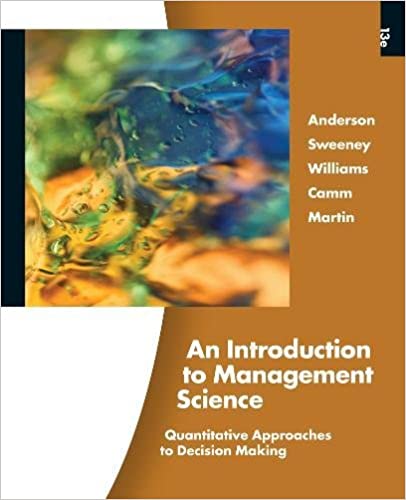
An Introduction to Management Science 13th Edition by David Anderson,Dennis Sweeney ,Thomas Williams ,Jeffrey Camm, Kipp Martin
Edition 13ISBN: 978-1439043271
An Introduction to Management Science 13th Edition by David Anderson,Dennis Sweeney ,Thomas Williams ,Jeffrey Camm, Kipp Martin
Edition 13ISBN: 978-1439043271 Exercise 22
An investor wants to select one of seven mutual funds for the coming Year. Data showing the percentage annual return for each fund five typical one- year periods are shown here. The assumption is that one of these five-year periods will occur again during the coming year. Thus, years A, B, C, D, and E are the states of nature for the mutual fund decision. 
a. Assume that the investor is conservative. What is the recommended mutual fund? Using this mutual fund, what are the minimum and maximum annual returns?
b. Suppose that an experienced financial analyst reviews the five states of nature and provides the following probabilities: 0.1, 0.3, 0.1, and 0.4. Using the expected value, this mutual fund, what is the expected annual return? Using this mutual fund, what are minimum and maximum annual returns?
c. What is the expected annual return for the mutual fund recommended in part (a)? How much of an increase in the expected annual return can be obtained by following the recommendation in part (b)?
d. Which of the two mutual funds appears to have more risk? Why? Is the expected annual return greater for the mutual fund with more risk?
e. What mutual fund would you recommend to the investor? Explain.

a. Assume that the investor is conservative. What is the recommended mutual fund? Using this mutual fund, what are the minimum and maximum annual returns?
b. Suppose that an experienced financial analyst reviews the five states of nature and provides the following probabilities: 0.1, 0.3, 0.1, and 0.4. Using the expected value, this mutual fund, what is the expected annual return? Using this mutual fund, what are minimum and maximum annual returns?
c. What is the expected annual return for the mutual fund recommended in part (a)? How much of an increase in the expected annual return can be obtained by following the recommendation in part (b)?
d. Which of the two mutual funds appears to have more risk? Why? Is the expected annual return greater for the mutual fund with more risk?
e. What mutual fund would you recommend to the investor? Explain.
Explanation
(a)Calculate the minimum and maximum ret...
An Introduction to Management Science 13th Edition by David Anderson,Dennis Sweeney ,Thomas Williams ,Jeffrey Camm, Kipp Martin
Why don’t you like this exercise?
Other Minimum 8 character and maximum 255 character
Character 255


